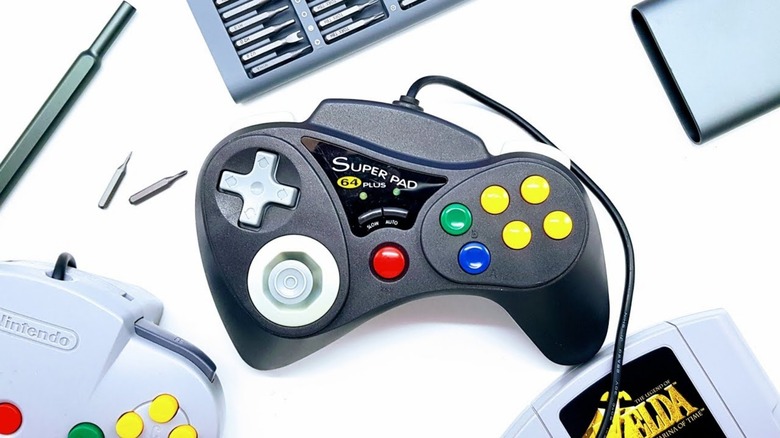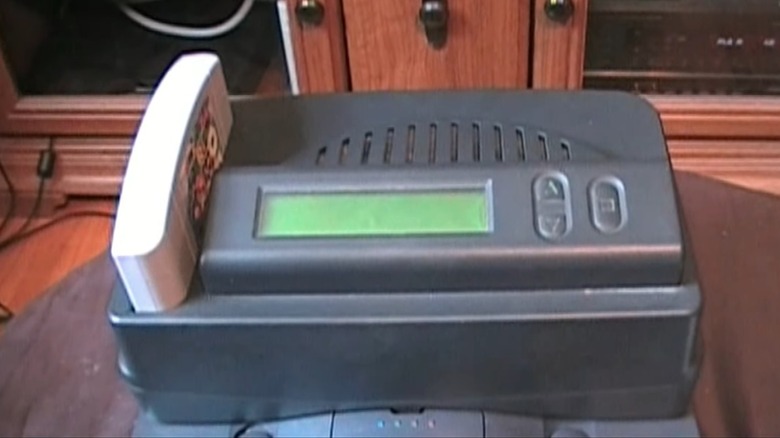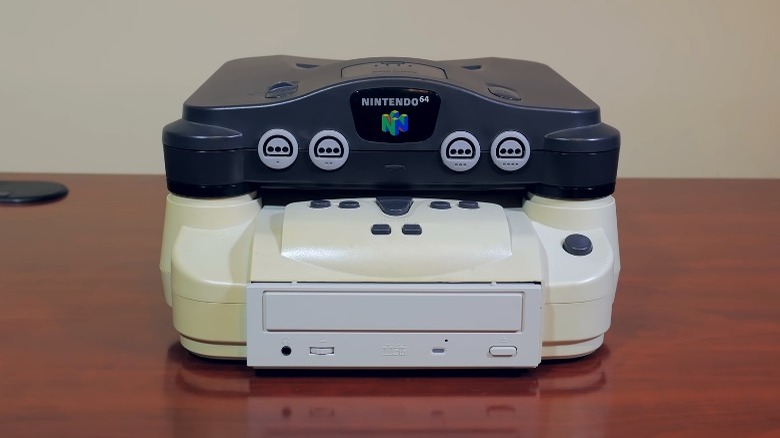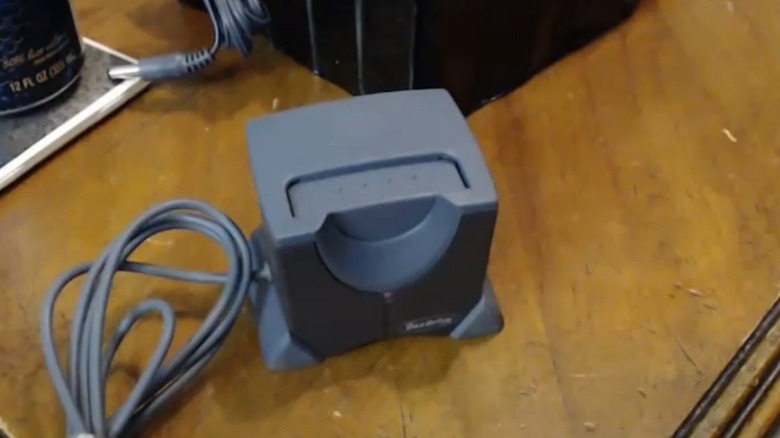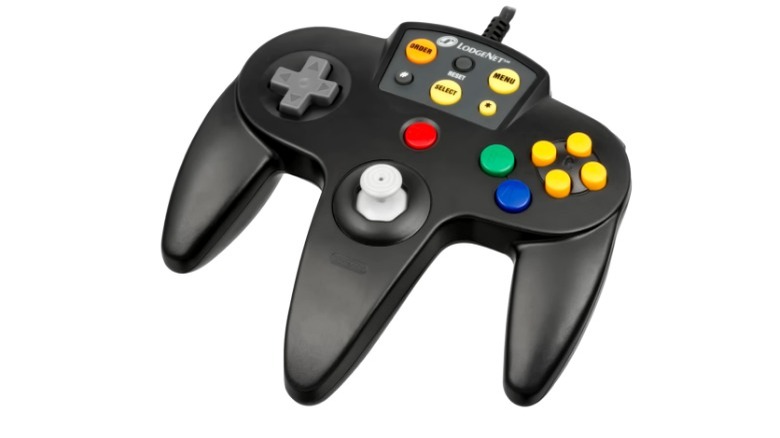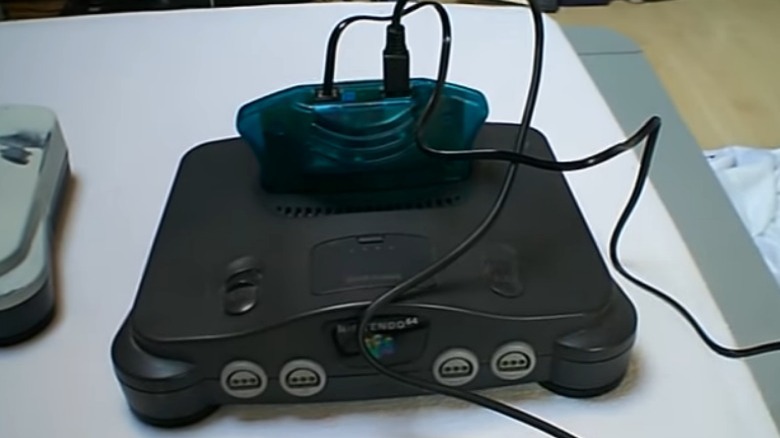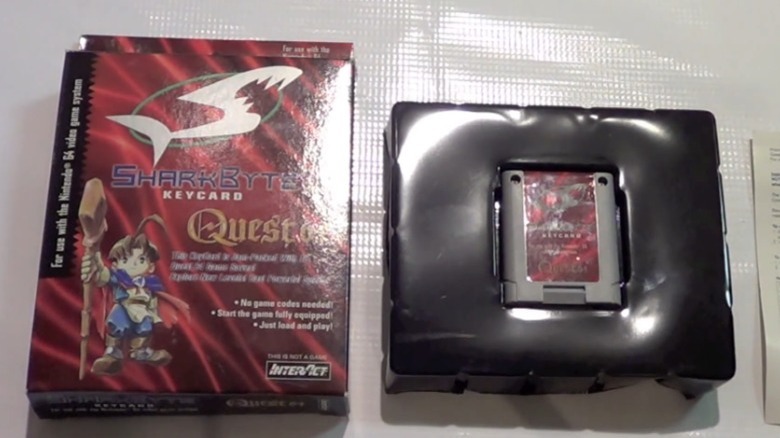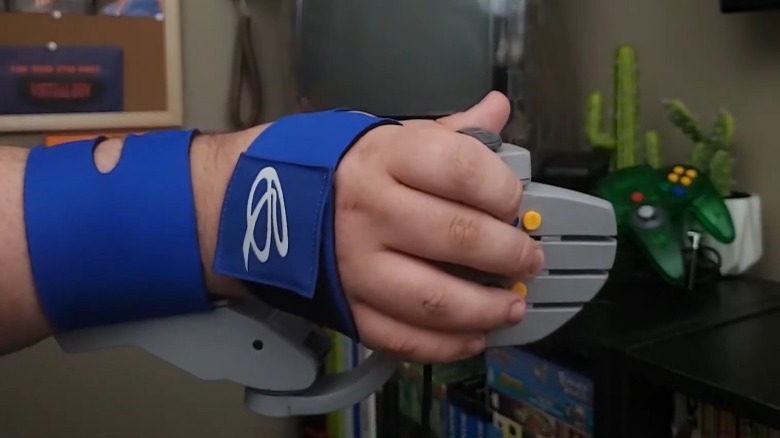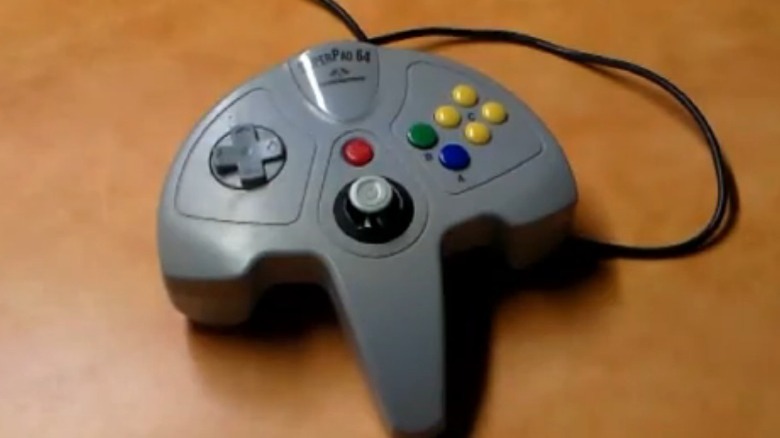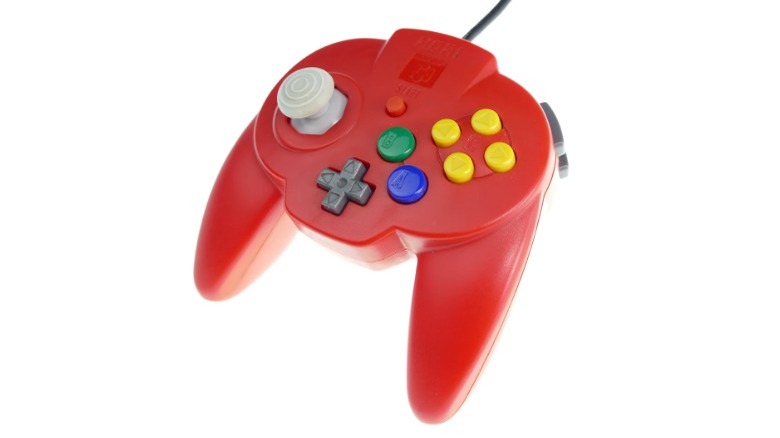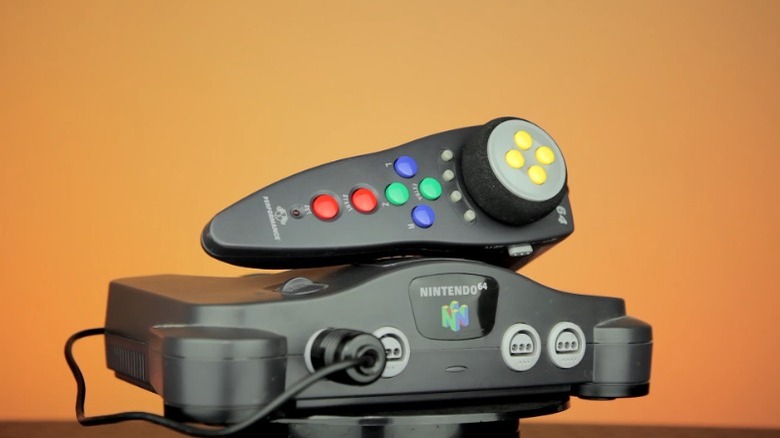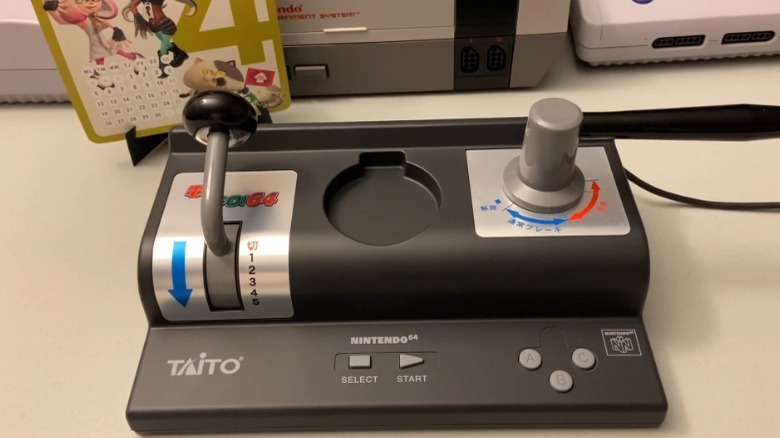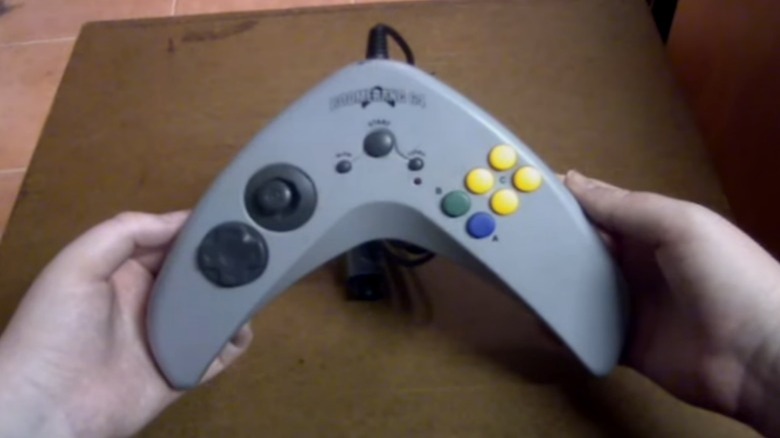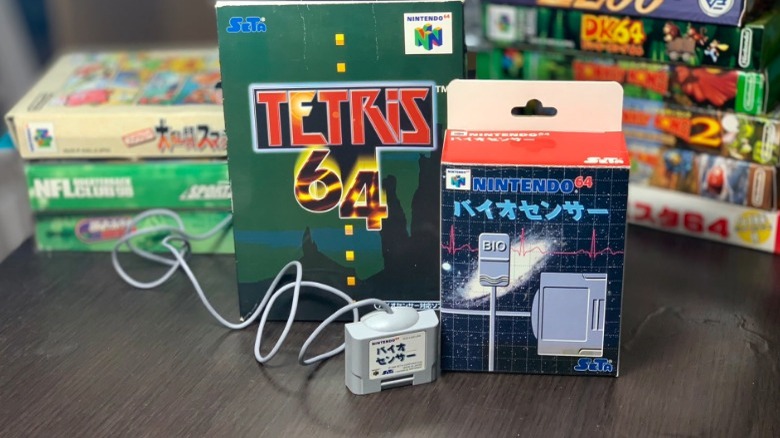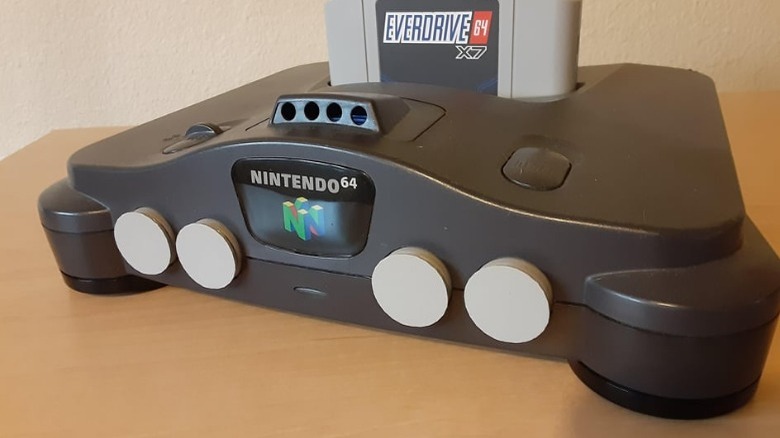The Most Bizarre N64 Accessories Ever Made
The Nintendo 64 was the height of video game accessorizing. Plenty of prior consoles saw their fair share of official and third-party products, but you couldn't get more colorful or in-your-face than the platforms of the 90s. You had the game code-manipulating GameShark, rumble paks (a precursor to modern haptic feedback), and controllers every color of the jolly ranchers rainbow. But while many accessories made sense, others were more eccentric.
For every budget expansion pack, you had a cleaning kit and two wacky controllers shaped like fishing rods. To be fair, by this period in the videogame lifespan, manufacturers had learned that gamers don't take to ideas like balance board d-pads or robotic operating buddies, so, many stranger N64 accessories weren't too experimental. But that didn't make them any less nutty. Nintendo and third-party manufacturers created specialized controllers, heartbeat monitors, and even internet modems for the N64. Here are some of the weirdest accessories ever made for the console.
Mr. Backup Z64
Whenever someone brings up the subject of emulation, it's usually punctuated with a caveat that emulators are a morally gray area. The programs might not be illegal, but downloading game ROMs from the internet sure is. This uneasy fact raises the question of how to legally secure game ROMs for emulation, and the answer is by ripping them straight off a cartridge or CD. However, that adds the layer of complication on how to rip game data. Harrison Electronics provided one solution for Nintendo 64 owners.
The Mr. Backup Z64 sports arguably the most ridiculous name of any N64 accessory, but it also succinctly sums up the device's purpose. As its title suggests, the Mr. Backup Z64 allows users back up their N64 games by burning roms onto zip disks. Once stored on the new format, gamers can load the diskette back into the accessory, while it is connected to the N64 and play it on the console, or they can insert the disk into a PC and play the game via emulator. Plus, users can store anywhere between six and 12 titles on one zip disk, depending on the game's size. That's certainly an unorthodox way to save shelf space.
Now, we cannot condone loading game ROMs onto the internet so others can pirate them, but there is nothing wrong with using the Mr. Backup Z64 to ensure your N64 collection remains safe and secure. But don't take our word for it; take it from the horse's mouth, Copyright.gov.
Doctor V64
Development kits are highly sought-after items. If you don't own one, how can you ever hope to produce a game for a particular platform? Usually, developers should only use dev kits provided by console manufacturers, but some third-party companies used to sell their own unofficial models.
The Doctor V64, which is completely unrelated to the Mr. Backup Z64, was developed by Bung Enterprises and advertised as a budget alternative to Nintendo's official Nintendo 64 dev kit. Why spend several thousand dollars on a real dev kit when you can buy one for only a few hundred? Just link the accessory to the N64 and PC, and test your code on the console. Or burn a game build onto a CD, insert it into a Doctor V64 plugged into an N64, and start testing. Doctor V64's CD ROM drive also plays music and movie CDs. Bung Enterprises did what Nintendon't.
Of course, Nintendo didn't endorse or even like the Doctor V64, especially because many users figured out how to pirate N64 software with it. Nintendo tried to sue Bung Enterprises and eventually succeeded, but despite this animosity, bona fide game studios such as Iguana Entertainment still used the Doctor V64. Apparently the lower price tag was too good for some developers to pass up.
DexDrive
You should always back up save files. If something happens to your console, all your progress will remain safe and sound. Many modern online subscription services let gamers upload their files to the cloud, but in all honesty, external hard drives are the way to go since you don't have to pay a yearly fee. But how do hard drives overcome the hurdles of disparate formats? Where there is a will, there's a way.
The DexDrive was produced by InterAct for gamers who wanted an extra layer of security for their save files. This accessory is essentially an adapter for Nintendo 64 memory cards that plugs into computers. Once connected, users can copy saved files from their cards to their hard drives. On one hand, this feature lets gamers play without fear of losing their progress or memory cards, but on the other hand, it also gives them an excuse (and means) to free up space on the memory card without permanently deleting save files.
If the DexDrive only let users back up their save files, that would have been more than enough, but the accessory had one more trick up its sleeve: Dexchange.net. By connecting to this website, gamers could share save files copied by the DexDrive with gamers all around the globe. Unfortunately, the service was discontinued in 2001.
Interact also developed and sold a DexDrive for the PlayStation One, which functions identically to the N64 version but sports a different card slot.
LodgeNet
Back in the late 90s, the United States was caught in the grip of Nintendo 64 fever. You could print out stickers of your favorite "Pokemon Snap" photos at local Blockbuster video rental stores, and McDonalds chains featured N64 kiosks where young gamers could play while waiting for their happy meals. Hotels got in on it too.
Technically it's chearing a bit here since the LodgeNet N64 controller isn't an accessory, but it isn't an N64 console, either. Before the advent of high-speed internet, Nintendo of America entered into an agreement with the pay-per-view service LodgeNet Entertainment to produce special controllers for hotel rooms. The idea was simple: Anyone staying in a room could rent a game for $5 to $10 an hour. Each LodgeNet system consisted of a modified controller connected to either a LodgeNet box or a TV, and, aside from a few additional buttons meant to navigate LodgeNet's proprietary menu, each functioned identical to their main console counterparts. Whenever someone rented a game, they effectively streamed it from a server in the hotel.
At the height of LodgeNet's partnership, the service boasted around 500,000 units, but not all played N64 games. LodgeNet also offered Super Nintendo and GameCube controllers, which could play games from their respective libraries. Regardless of the setup, LodgeNet controllers allowed gamers to unwind with rental games. Plus, LodgeNet controllers could also act as remotes for their linked televisions. Where else can you surf cable channels with an N64 controller?
SharkWire Online
Almost every gamer has heard of the 64DD, Nintendo's failed Nintendo 64 add-on that was supposed to leverage the power of oversized floppy disks for console gaming. Ultimately, the console's only claim to fame, aside from its inability to attract audiences, was its RandNet service, which connected the N64 to the internet, albeit only in Japan. Because the 64DD only released in Japan. If Western audiences wanted to bring their Nintendo 64 online, they would have to cheat a bit.
GameShark was a popular brand of third-party cartridges and discs designed for PlayStation, Xbox, and Nintendo platforms. Just insert one into your console to inject cheat codes directly into a game. While the GameShark's developer mostly stuck to these roots, they saw potential in the internet, which is why they created the SharkWire Online. This accessory is essentially a modem you can plug into your N64 to connect it into the internet. When the SharkWire service was still active, users could surf the web (mostly) and access emails on their N64s. And since this was a GameShark product, SharkWire also let gamers post and download save files, cheat codes, and game tips.
Since 64DD and its RandNet service never launched stateside, if gamers wanted to go online with their N64, SharkWire Online was their only option. However, this device released before online multiplayer was even a concept, so it really only just turned Nintendo 64s into television-bound PCs. But what gamer wouldn't want to surf the internet on such a big screen?
Sharkbyte Keycard
The GameShark was one of the most popular cheating devices for consoles ever produced. Each accessory came with thousands of preloaded cheat codes, let users create their own, and even acted as memory cards. But even with all the GameShark cheat codes active, gamers still would have to play the games. Unless they purchased a different GameShark product, that is.
The Sharkbyte Keycard is, at its core, a Nintendo 64 memory card with preloaded cheat codes and save files. These accessories were designed to let gamers cheat their way through a title (obviously), while also getting to experience its later levels and unlocks sooner. Only two varieties of Sharbytes were produced: one for "Mortal Kombat 4" and one for "Quest 64."
In theory, the Sharkbyte Keycard is a great idea, but it is self-defeating in execution. Each keycard only works with one specific game, so why shell out the money for a card when you can purchase a GameShark compatible with every N64 title available? Why buy a memory card that leveled up for you when you can just use a GameShark to max out stats instantly? These questions might explain why the manufacturers stopped at only two games and didn't make a Sharkbyte Keycard for, say, "Body Harvest" or "Jet Force Gemini."
Reality Quest Glove
Mattel's Power Glove was bad, but we all loved it. The accessory didn't function as advertised, but something about controlling a game with an expensive glove is just plain endearing. The Power Glove ended up being a flop, but that didn't stop another company from trying again with the Nintendo 64.
The Reality Quest Glove is, for all intents and purposes, a more functional version of the Power Glove, except it isn't actually a glove. This N64 accessory has more in common with a medical splint, as it wraps around the user's forearm and hand. The controller portion of the "glove" consists of a hand-shaped section with all the buttons on the front, as well as a joystick near the thumb. Except that isn't a joystick; that's the d-pad. The actual joystick consists of a wrist-mounted gyroscopic rocker. Yep, the Reality Quest Glove is another example of motion controls.
In essence, the Reality Quest Glove is a one-handed controller, which is perfect for gamers who have trouble using (or don't have) a left hand. Unfortunately, that means gamers who either can't use or lack a right hand can't use the glove. But then again, according to people who used it, you might not want to since the accessory's gyroscope is too sensitive even on its lowest setting. Still, at least the Reality Quest glove is more functional than the Power Glove, and the manufacturer also made a PlayStation One-compatible version.
SuperPad 64
Every good game controller needs a name, something to advertise its capabilities and get audiences hooked. Console manufacturers usually choose these names with care, but third-party companies are a little more slapdash, which can cause confusion, especially when two unrelated accessories share the same name.
The "SuperPad 64" can refer to one of two third-party controllers. The first is the Performance SuperPad64, which does away with the N64 controller's signature side prongs. The result makes this third-party accessory look like a plastic stingray, but despite the controller's name, the sacrifice doesn't improve performance. If anything, this SuperPad is reportedly worse than the vanilla N64 because its buttons, especially its d-pad, aren't as solid. But the analog stick is better.
The name "SuperPad64" can also refer to the InterAct SuperPad64, also known as the InterAct SuperPad64 Plus and the InterAct MakoPad64. That naming convention is almost as bizarre as the design. Unlike most N64 controllers, this device only features two grips, but for some unexplained reason, these handles are asymmetrical. The left grip is way too big, while the right handle is too small, and users have to hold the controller at an angle. This design has left audiences divided; some gamers like the controller, but others don't.
Whichever controller comes to mind when someone utters the words "SuperPad 64," it is still a weird one.
Horipad Mini 64
More often than not, bizarre controllers are the result of form over function; they don't work well because manufacturers were more concerned with making a unique-looking controller than a comfortable or durable one. But the Horipad Mini is not one of them. A strange controller that is actually good? Now that is weird!
At first glance, the Horipad Mini 64 almost looks like a Nintendo Gamecube controller. The device only sports two handle prongs instead of the N64 controller's usual three. Moreover, the d-pad is below the analog stick, and the thumb stick sports the larger and more robust design of the Gamecube's. But this Horipad has C-buttons instead of a C-stick and doesn't include X or Y buttons. Appearances aside, this accessory was, in fact, made for the Nintendo 64, not Gamecube owners with small hands.
According to reviews, the Horipad Mini 64 is superior to other third-party N64 controllers, but more surprisingly, it is one of the few unofficial accessories that surpasses the standard N64 controller design. These claims aren't stating that the vanilla controller was a piece of art, just that most non-Nintendo-manufactured controllers weren't as good. And that the Gamecube controller is the closest Nintendo has ever come to perfection.
Ultra Racer 64
Most gamers use either a controller or a racing wheel for their racing games. The former lets players enjoy the game without buying extra accessories, the latter lets gamers utilize their real-world driving skills to win a video game. Apparently, one third-party accessory manufacturer couldn't decide between the two and created a hybrid instead.
The Ultra Racer 64 by Performance (the same company behind one of the SuperPad64s) looks less like a Nintendo 64 controller and more like a TV remote with a wheel on top. Most buttons are on the accessory's face, but the controller seemingly lacks the A and B buttons, as well as the analog stick. That observation is only half true. The Ultra Racer 64 replaces the analog stick with that giant wheel up top, and the A and B buttons have migrated to where the Z button usually sits — and have combined into a single trigger that switches between the two.
Because of the Ultra Racer 64's design, the controller doesn't work with many games since there's no analog stick to push up or down. Yes, even racing games are hamstrung since the controller has trouble navigating their menus. Credit where credit is due, though, according to reviews, when the Ultra Racer 64 is used to control digital cars in an actual race, it works rather well. The controller is far from perfect, but the joy of using a handheld wheel to win a race is undeniable.
Densha de Go! Controller
Gamers are no strangers to unusual controllers. The "Steel Battalion" controller is the gold standard of dauntingly gargantuan accessories packed to the plastic with buttons, but its sheer size and complexity adds to the experience. The Nintendo 64 also had its own proprietary controller designed for a specific adventure.
The Densha de Go! Controller was developed by Taito for the game "Densha de Go! 64," the port of a popular Japanese train simulator arcade cabinet. Like many franchises, the game was ported to home consoles when that medium picked up steam, but unlike other arcade games-turned-home console franchises, Taito didn't try to adapt the game to fit a new controller. The company instead stuck to what they knew worked.
When Taito released the first "Densha de Go!" game, the arcade cabinet featured a unique control mechanism that resembled a train driving console, because Taito wanted to provide as faithful a replica as possible. The controller even includes a divot for pocket watches because real Japanese train driving consoles feature them to help train conductors keep time. This design philosophy continued over to the N64 version of "Densha de Go!." While the "Densha de Go!" controller is a somewhat common sight in Japan, most Western audiences have probably never seen one, let alone heard of one.
Nuby's Boomerang Controller
Nintendo essentially invented controller rumble functions with its rumble pak, but that battery-operated accessory was sold separately. Official game controllers weren't built with rumble motors until the next console generation, but one third-party manufacturer gave integrated rumble a shot with the Nintendo 64. It didn't work out too well, but at least they gave it the old kangaroo college try.
The name "Nuby's Boomerang Controller" is fitting since the accessory looks like a gray boomerang. Plus, the more meme-oriented readers will probably say the concept PlayStation 3 controller drew inspiration from it. Aside from the unique shape, the Nuby's Boomerang Controller's most noteworthy feature is its built-in rumble motors. While these are powered by batteries, just like the rumble pak, they were built into the controller before any other manufacturer could put a similar idea on the market.
Unfortunately, even though the Nuby's Boomerang Controller can proudly claim it was the world's first true rumble controller, it can't proclaim it was the world's first quality rumble controller. According to reviews, the accessory's rumble is lackluster. And to make matters worse, the controller is difficult to hold for long periods of time, mostly due to its admittedly unique angular design. While Nuby's ahead-of-the-curve thinking didn't pan out for its Nintendo 64 aspirations, at least the controller demonstrated game peripherals could one day be built with internal rumbles, which is now standard in most controllers.
SETA Bio Sensor
Nintendo has a strange obsession with monitoring gamer hearbeats. The Wii Vitality Sensor is arguably the most famous example, but it is not the first.
The SETA Bio Sensor was the product of a collaboration between Nintendo and the SETA Corporation. As you can probably guess by the name, this accessory can monitor gamers' heart rates. Like the Wii Vitality Sensor, the SETA Bio Sensor plugs directly into the Nintendo 64 controller, specifically its controller pak slot, but instead of clamping over a finger, the SETA sensor clips onto earlobes. Doesn't sound comfortable, especially during lengthy game sessions.
While the Wii Vitality Sensor never saw the light of day, the SETA Bio Sensor actually was released, but only in Japan. And, it only worked with one game, "Tetris 64," which was also a Japan-exclusive. To add to this pattern of one-hit blunders, the bio sensor only had one function: speed up or slow down the game depending on the user's heart rate and game mode.
Nintendo just can't catch a break when it comes to accessories that detect heartbeats. The company only made a successful device when it created the Joy-Con IR sensor, if only because heart rate functionality was patched into the component at a later date.
Mad Catz Expansion Port Cover
While many third-party manufacturers created budget Nintendo 64 controllers, some also produced alternative accessories for the console's various slots. Most were only designed for the controller's pak port, but one was made for the jumper pack slot, and it came with an even weirder accessory.
Back in the day, Mad Catz was the go-to third-party accessory maker, partially thanks to its huge library of N64 accessories. The company even sold its own Expansion Pak alternative, the High-Rez Pack. The accessory functions just like the official Expansion Pak, except it doesn't come free with every copy of "Donkey Kong 64." Mad Catz's pack also has an odd extra in the form of a port cover that kind of looks like those engine parts that sometimes stick out of car hoods. The result? The cover kind of makes the N64 look like the hood of a sports car.
Ultimately, Mad Catz's expansion port cover serves no purpose other than looking odd. The accessory doesn't improve the High-Rez Pack's performance, and users can just use the bog standard cover that comes with the N64 instead. But just because an accessory is otherwise useless, doesn't mean we can't like it. To quote Marge Simpson, "I just think they're neat."
